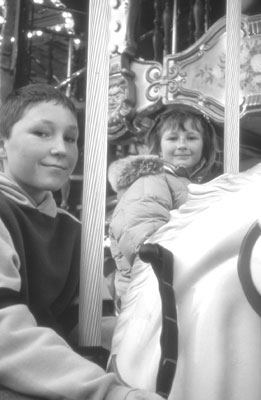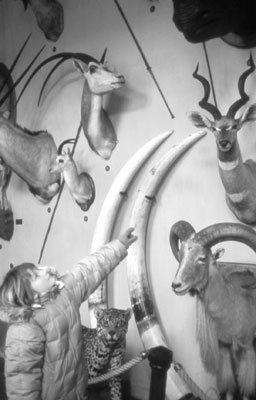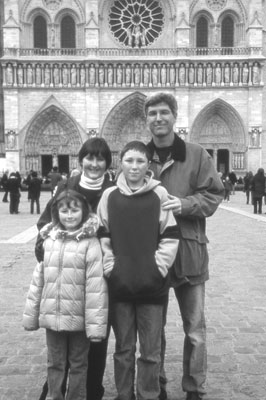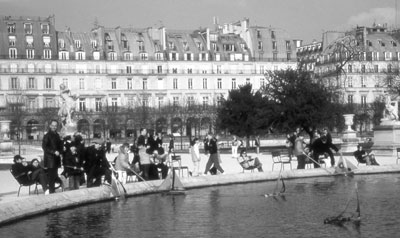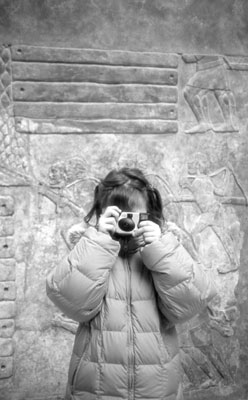February in Paris — a perfect time for a family visit
by Yvonne Michie Horn, Santa Rosa, CA
“Je voudrais pasta avec fromage, s’il vous plait.” Eight-year-old Taylor, who at home is highly suspicious of anything stranger on her plate than noodles with cheese, had practiced her dining-out phrase to perfection. Her brother, 12-year-old Max, on the other hand, was ready to try anything, with one exception: “No innards.”
While “February in Paris” doesn’t have the same hummability as “April in Paris,” our family group — parents, kids and me, the grandmother — discovered that there is no better month to introduce youngsters to the City of Light.
A city transformed
Yes, it was brisk, so brisk that we came upon fountains metamorphosed into frozen bouquets, but the clear and sunny skies never asked us once in our 10-day visit to pop open our umbrellas.
In February, a winter-scrubbed Paris gleams through the bare branches of its boulevards’ trees, a Paris that, with tourists all but nonexistent, belongs to those who live there. With our decision to rent an apartment, we planned to fit right in.
Accommodations
February was school break for both the children, making our getaway possible. My son-in-law, Alan, put himself in charge of translating frequent-flyer mileage into air for us all. I, a dedicated Francophile (especially when it comes to Paris), took on the task of finding us a suitable place to stay.
My fingers did the walking through websites, coming to a halt at the easily navigated, descriptive and informative site of Chez Vous (phone 415/331-2535 or visit www.chezvous.com). The name Chez Vous was not new to me. Headquartered in Sausalito, California, a town reassuringly close to my Northern California home, it has a long and reputable history as a rental company of spiffily decorated, well-equipped and -maintained apartments in Paris and beyond.
I clicked through choices galore (organized by price, arrondissement and number of persons accommodated) to come to a halt at 12 rue Jacob in the sixth arrondissement. After a deep gulp at the price tag, $640 per night, the 1,000-square-foot apartment with two bedrooms, 2_ baths, fully equipped kitchen, dining room and spacious living room (with a convertible sofa) began to look downright reasonable when considering the dollar against the euro and the going rate for hotel accommodations in the city. Added to that was the plus of not having to eat every meal out.
The location was superb, just around the corner from rue de Buci, a market street of incomparable abundance that would make dining at home both easy and a gastronomical delight. In addition, from our courtyard door our feet could quickly take us to the banks of the Seine and from there to many of Paris’ most memorable sights. For farther journeys, a choice of close Métro stations could whisk us on our way.
Navigating the neighborhood
Included in Chez Vous’ website was “Neighborhoods.” A click took me to ours, St-Germain-de-Prés, which began with a description written by San Francisco writer and part-time Parisienne Melinda Burgener. “Rich in history and trendy as tomorrow,” I read, “Paris doesn’t get any smarter than St-Germain.”
Then came an “insider’s” listing of things to see, do, buy and eat — many of which I’d not heard and among them suggestions appealing to children. With that, I decided to click on all the “Neighborhoods” — eight in all — each with equally interesting suggestions.
For example, a grisly, kid-appealing piece of French Revolution history would be but a 3-minute walk from our apartment. In the Cour du Commerce St. André, Dr. Joseph-Ignace Guillotin thought up his “humane” device and practiced it to perfection on sheep in a courtyard there. Quickly I added the Cour du Commerce to our intention of taking in the Conciergerie on our visit to the Ile de la Cité, the next-to-the-last stop for those destined for the guillotine — including France’s last queen, Marie-Antoinette — before being trumbled off to the Place de la Concorde, where out of 2,500 beheaded during the French Revolution, 1,119 lost their heads.
As I contemplated visiting Paris with my family — the children’s first passport journey — it struck me that guidebooks underestimate youngsters’ ability to enjoy the reality of someplace else.
Even Cadogan, the U.K. company that puts out a series of guides I have always considered particularly worthwhile, in its “Take the Kids, Paris” edition, while it starts out well in its introductory paragraphs, “You may find that your kids’ greatest pleasure comes from seeing the little quirks of everyday living that make Paris different,” goes on to devote one-third of its pages to Disneyland Paris. Quelle horreur! Rick Steves did better in the three pages he devotes to youngsters in his “Paris 2004.”
Museums made easy
One bit of invaluable information gleaned from Steves’ guide was the little-known fact that a Monument and Museum Pass (sold at museums and main Métro stations — one day, €18; three days, €36, and five, €54) not only gives discounted admission but allows holders to completely avoid lines. While passes aren’t necessary for children, as most museums are free to youngsters under 18, a pass for adults is not only a money saver but eliminates what kids detest even more than their grownup companions: standing in a queue.
February in tourist-absent Paris takes care of most lines; in fact, we encountered just one, at the perpetually people-ringed-in-any-season Musée d’Orsay. Feeling smug, youngsters in tow, we stepped right up to the door, flashed our passes and walked right in.
We also followed Steves’ advice to make museum visits short. Another good reason for a pass is that it eliminates the feeling of needing to see what amounts to too much in a single visit. At no additional cost, you can go back again and again.
At the Louvre, on our first visit, we scooted about with a list and museum map in hand to take in naught but a half dozen of its acknowledged masterpieces. Down this hall, up this staircase, into this wing and, voila!, the “Mona Lisa”!
Another visit was dedicated solely to mummies, with another to the Assyrians that ended in the sunlight-flooded hall housing the whimsical, huge, winged bulls from the Palace of Sargon II.
Another time, Max, a fledgling chess player, wanted to take a second look at an onyx chess set he’d earlier admired. By now, we knew our passes could whisk us through a side entrance on the rue de Rivoli, avoiding the long metal-detector lines at the courtyard pyramid, making a quick visit to the chess set possible.
Other museums the kids loved included the Musée d’Orsay, where we took the escalators straight up to the Impressionists, to which they’d been introduced at home via a library book.
The Pompidou Center was a hit for the amusing Stravinsky fountain in front and its “inside out” architecture. Here, we concentrated on the fourth floor’s contemporary pop art collection where we all enjoyed pieces we could literally get into as well as those that presented familiar objects, like chairs, in creatively different and smile-producing ways.
Another “Neighborhoods” suggestion, in this case the one devoted to the Marais, alerted us to Le Musée de la Chasse et de la Nature (60, rue des Archives), housed in a magnificent 17th-century mansion.
First came rooms of cases devoted to various guns of amazing ingenuity used for hunting through the ages. A final room was filled with more than 100 head trophies, many of endangered or now completely vanished species, along with full-body male and female gorillas and an enormous stuffed crocodile.
The consensus of grown-ups and kids: this was a fascinating, sobering look at what one would hope can no longer happen. “It made me sad,” said Max, “but I’m glad I saw it.”
Kid-friendly sights
More kid-memorable visits — Napoleon’s tomb, for the elaborate tomb itself and his stuffed horse and dog in the east wing of the Army Museum; the Naval Museum, for Napoleon’s ornate boat and a display of fanciful ship figureheads; Sainte-Chapelle, for its glorious stained-glass windows; the Eiffel Tower, climbed to its very top, and the flower and plant market on Pl. Louis Lépine on Sunday, when it flutters as a bird market.
Only-in-Paris activities that we particularly enjoyed included pushing toy sailboats around the pond in the Tuileries in the company of French children; visiting the playground in Luxembourg Gardens, for its imaginative equipment unlike that at home and, again, the opportunity to be with French children; watching the ice-skaters on the rink set up in front of the Hôtel de Ville followed by a ride on the adjacent carousel; sipping hot chocolate while seated under the heat lamps at sidewalk cafés; taking the Métro, particularly figuring out on the maps which lines would take us where we wanted to go, and walking down to the Seine at night to stand on Pont du Carousel to see the lights of Paris reflected in the water.
Living like locals
Our apartment quickly began to feel like home, with its tall windows looking out over the courtyard and filling rooms with light. Daily we blessed its spaciousness that saved us from overdosing on multigenerational togetherness.
Popping out in the morning to head to the boulangerie on the rue de Buci was our youngsters’ delight, with Taylor quickly adding croissants any which way to her list of approved foods. Gerard Mulot, at nearby 76 rue de Seine, a Chez Vous “Neighborhoods” find, became our favorite patisserie not only for its choice-defying counters laden with jewel-like cakes and tarts but for impeccably prepared salads and entrées that we carted back to the apartment for dinner.
“Neighborhoods,” too, alerted us to non-pocketbook-wrenching restaurants on the evenings we decided to eat out. La Maison de la Lozère (4 rue Hautefeuille) was a hands-down favorite. Operated by the region’s tourist office, the tiny restaurant serves 3-course meals of impeccable local fare (starting at €16) that made us all long to get on the first train to the Lozère. By chance we had made dinner reservations for a Thursday, the only day when a particular recipe for potatoes is on the menu, one that has neighborhood aficionados clambering for a table. Max and Taylor are still talking about “those stretchy potatoes.”
We found museum cafés a good choice for casual and inexpensive lunch fare in interesting surroundings. The high stools and long tables of the Pompidou’s self-serve café overlooks its bustling entry floor; Musée d’Orsay’s café is conveniently sandwiched in between the Impressionists.
Too soon, we hauled our suitcases down the winding staircase that had seen our feet come and go for 10 days to cross the cobbled courtyard and make our way for the final time through the little door within the large entry door of 12 rue Jacob. Our shuttle to the airport awaited (Blue Shuttle; phone 888/426-2705 or visit www.airportshuttle.fr), the same shuttle that had taken us there.
Tucked into Max and Taylor’s backpacks were the throwaway cameras they’d taken along, now filled with captured memories, along with the journal each had kept to record in words and drawings the happenings of each day.
Undoubtedly, each of us will return to the City of Light, perhaps time and time again. But never will it be the same as discovering February in Paris with parents and kids, and grandmother, too.
Yvonne Horn received a partial discount for her Chez Vous accommodations but has stayed with Chez Vous on three previous occasions paying full fare.


